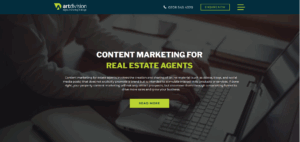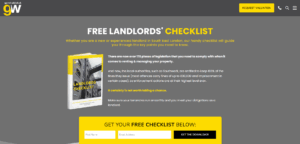An Estate Agent’s guide to AML Compliance
AML compliance will never be your favourite task, but it doesn’t have to be a concern. Our movebutler platform is designed to be relied on as a full AML support system.
If your website is struggling to get off the ground or its performance has stalled, there are lots of ways improve it. In fact, a series of small, intelligent changes can set you well on your way to competing with larger Estate Agencies and winning business in areas you did not expect.
It’s impossible to provide an exhaustive list, so we’ve teamed up with Art Division and decided to focus on five interesting, innovative and agency-oriented solutions. Each one will help you increase traffic to your website, and in many cases, persuade visitors to take the next step – whether booking a valuation or enquiring further.
It’s worth remembering that each of these suggestions work best when they are built into a co-ordinated marketing strategy – even though it’s worth considered the merits of each one individually.
Local SEO refers to how prominently your business appears in local, online listings on the search page. For example, if someone sitting in a café half a mile away from your office searches for ‘Estate Agents Manchester’, you want your business profile to pop up first – not someone else’s.
Stats show that 51% of people use Google Maps to look up local businesses, and an even larger, 72% start with Google Search (which also links to local listings on Google Maps). So, it’s essential to improve your presence in local searches as much as possible.
Your ranking will improve as you get more (and better) reviews, adding keywords related to your business, explaining the services offered, and including schema markup on your website so Google can extract your business details.
But that’s not all. An excellent way to expand your reach further is to build area specific pages which attract new leads from elsewhere. You might not have an office two miles away in the next district, but you can build an SEO optimised page aimed to capture customers who live there.
With the proper structure, information, keywords and presentation of your services, this is an easy way to expand your reach. This will help you to dominate local SEO searches without even being located in the area. And just think, you won’t have to invest in a new office or hire new staff. And even if it doesn’t work out or it’s too competitive, you lose very little from trying.
Take a look at this area page example here, designed by web design agency Art Division.

‘How could anyone make blogging an ‘innovative’ solution in 2025?’ you might ask.
Blogging has been around for well over two decades, but its success depends upon how you use it as an Estate Agent. Let’s explore how blogs can be designed to attract more web traffic and increase your conversions.
First, you need to create blogs which provide enduring value for your customers and align with their personal profile. For example, a ‘Landlord Responsibilities & Regulations’ blog has an exceptional amount of mileage because it is always relevant, easy to update as the rules change, and can be adapted to particular segments of the market (e.g. commercial or HMO landlords).
Next, it is critical to make your blogs findable. You will need to optimise the page, text and images for your chosen SEO keywords, and then build backlinks to the blog. It’s an excellent idea to augment titles and headings to reference your area, so that the page ranks highly in Google Search for customers that live near you. For example, ‘Landlord Responsibilities & Regulations in Manchester’.
This drives meaningful traffic to your website – not just any buyer, seller or landlord who lives on the other side of the country.
If you embed CTA popups in the blogs aimed at the right customer (e.g. ‘landlord’, ‘seller’ etc.), then you will further increase your chance of conversions.
Another useful step is to include key insights from the blog in your email campaigns, and then link back to the blog, so you are increasing the reach even further while directing more traffic back to your website.
Finally, you should promote the blog through paid and organic social media channels to your target customers.
Follow this link if you need help with your blog and content marketing strategy.

Estate Agency websites need to deliver more value than the ubiquitous property portals.
Rightmove alone boasts over 85 million visitors a month and is often the main place that buyers spend their time when looking for property. So, one of the ways to keep customers on your website is to offer them unique features and a depth of content that they won’t find elsewhere.
Not only does this build trust, but it increases engagement and persuades people to explore your website instead of your competitors’ sites.
So, what unique features might you offer? Let’s look at a handful:
If you’re selling multiple units within a development, you should consider creating a specific ‘development page’ like this example.

Why? Because it will help you to build closer relationships with developers, who in turn are more likely to recommend your services to buyers, sellers and landlords. These pages are designed to display a gallery of images alongside highly adjustable text sections, meaning it is easy to optimise for SEO purposes – and attractive to potential customers.
The beauty of this approach is that you do not have to start out as an official partner with the developer, or own the whole development. Instead, your promotion in Google Search results makes it likely that buyers and sellers will find you, and want to enquire further. And at the same time, this builds a good relationship with the developer who is all too happy to see their building receive free publicity.
An excellent way to reach more customers through your website is to create a ‘bait’ campaign.
A bait is commonly a useful, in-depth document which is locked behind an email signup on a purpose-built landing page. For example, it might be an insider’s guide to the Renters Rights Bill which explores the local market impact for your landlords, or a checklist for renting a property (like in this example).
Once you have created this ‘bait’ document, it can be hosted on a landing page. This page can be promoted through Google Ads, banner ads and the Google Display Network (GDN). It can also be promoted through an advert and sign-up form on Facebook. You could add a pop-up to your homepage promoting it to all visitors, or target a particular CTA to customers reading (e.g.) a landlord blog.
To get access to the material, the customer will have to provide their email address and agree to receive your emails. That then allows you to build your email list with the signups, and then funnel the users into your regular campaigns, which in turn will link back to your website and increase traffic and conversions.

We hope you can put these 5 strategies to good use for your website.
There are so many tips, tricks, adjustments and improvements on the market that it can be hard to know where to start. And one thing that makes it harder is that, to succeed, these tools require a marketing infrastructure to keep track of leads and encourage them to convert.
So, if you need help promoting your Estate Agency website – or if you need a new website altogether – don’t hesitate to get in touch with Art Division. They design leading websites for Estate and Letting agents across the UK and create a marketing-ready infrastructure so that your campaigns are successful over the long term.
AML compliance will never be your favourite task, but it doesn’t have to be a concern. Our movebutler platform is designed to be relied on as a full AML support system.
See how a connected ecosystem helps you simplify your day, move transactions forward faster and deliver a more consistent sales journey from instruction to completion.
Launching 26 February 2026, National Estate Agent Day will celebrate and champion Estate Agents for their hard work, dedication and vital role.